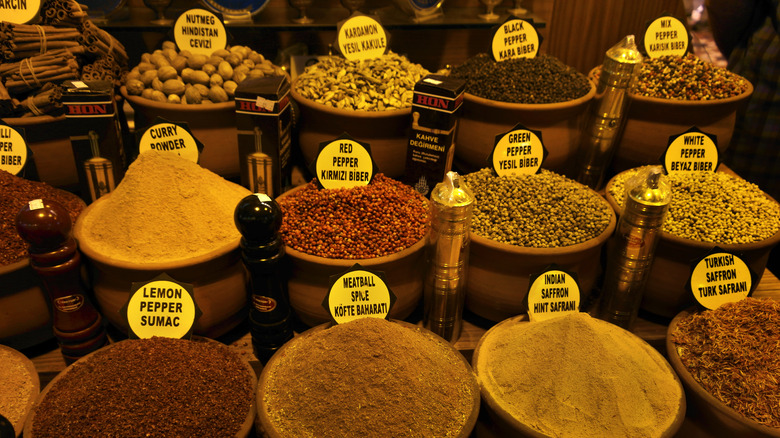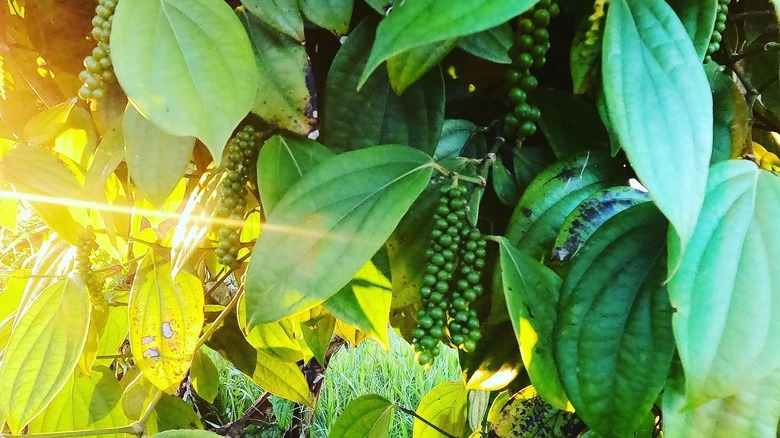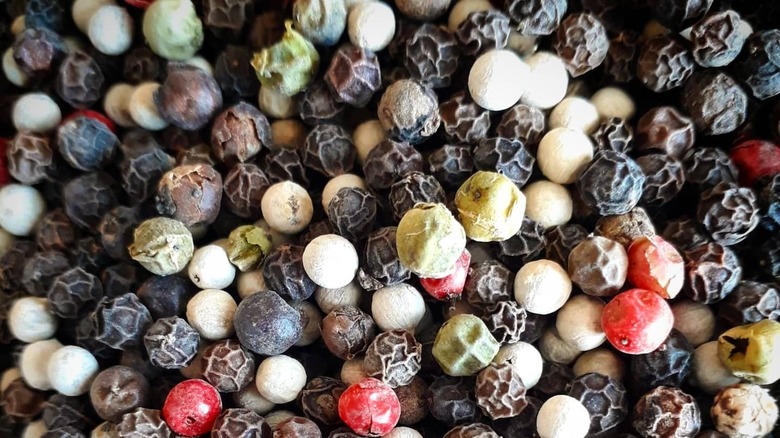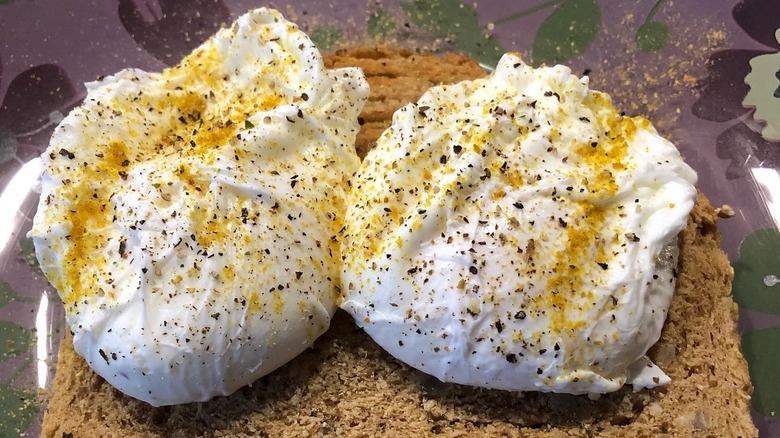Most Of The World's Black Pepper Comes From This Country
It has been a household staple for as long as anyone can remember, the quintessential combination of salt and pepper settled neatly on top of your dinner table or kitchen counter; almost always used together. It's an age-old, unspoken rule that if you have one, you must have another, and even though we have access to more spices today than we know what to do with, almost every recipe using spices requires you to start off with salt and pepper first. But while salt tends to stand out brightly on the pallet, pepper tends to take the back seat. But that doesn't mean that it is any less important than its counterpart.
Black pepper (Piper nigrum) is an unripe fruit that is dried and cooked to procure a spicy heat, known for its uncanny ability to make people sneeze (via Almanac). The peppercorns grow on a long vine in clusters kind of like grapes would, says Spice Jungle, and are hand-harvested. Today, black peppercorns are 20% of the world's total spice trade and are primarily grown in the country of Vietnam.
Black pepper in Vietnam
Black pepper, also referred to as hu jiao, kali mirch, pimienta, fulful, poivre, pepe, and pfeffer, is well beloved around the world for the subtle kick it brings to our food. The plant grows in a colorful variety, appearing in black, white, green, or red (via McCormick Science Institute). It has been an essential part of our dinner plates for centuries, bringing us a spiciness thanks to the piperine trapped in the little fruits, and today World Atlas tells us that Vietnam is to thank for fueling our pepper-related needs. The country of Vietnam produces about 34% of our total global production. The runner-ups for the title of number-one pepper producer are Indonesia and then India.
K-Agriculture reports that in 2021, Vietnam exported about 260,000 tons of pepper, and exported 99,540 tons by May of 2022. A majority of Vietnam's production is dedicated to exporting to non-peppercorn-producing countries. Like coffee plants, peppercorns can only thrive in hot, humid tropical climates, so the world relies on countries like Vietnam to feed their black pepper obsessions.
The history of black pepper
Like many other crops today, where black pepper is grown in the highest quantity today, doesn't correlate to where the plant originated. Even though Vietnam is the current king of peppercorn, the plant species are native to India's Malabar Coast. Britannica says that the spice was widely cultivated and used both medicinally and as a treasured condiment. It quickly became the main aspect of their trade economy as black pepper was introduced globally.
World History claims that in ancient India long pepper (Piper longum) and black pepper (Piper nigrum) were the two of the most sought-after varieties of the crop. Though we have all but forgotten the long pepper in place of the black pepper, it was once the most popular of the two in Europe during the Greek and Roman empires. According to the World Food Story, there are records of black pepper dating back 4,000 years. Before oil coined the term, black pepper was referred to as "black gold."
Unlike the cheap, pre-ground kernels you get from the store today, pepper used to be wildly expensive. Plinius Elder, the Roman author of "Natural History" said that while pepper was considered essential to every dish, it was marked at a high price — sometimes being so exorbitant as to cost half of a soldier's monthly salary per pound.
Culinary uses for black pepper
In today's culture, we utilize black pepper less for its medicinal purposes, but for the power of its flavor. In addition to being delicious on almost anything, Healthline says that adding black pepper to your diet is good for your body as well as your plate. Black pepper contains a chemical called piperine, which we mentioned before, is responsible for the pungent spice peppercorns are known for. It's also known to fight free radicals and improve digestion.
Now that we know that consuming black pepper is healthy, let's talk about what ways we can use it. You can buy back pepper pre-ground or fresh and grind it yourself over a classic Cacio E Pepe recipe, into a cheesy Gruyere Popovers, or add heat to a flavorful pizza sauce. It is perfect for breakfast, lunch, dinner, and even dessert if you want to add some depth to a simple spiced apple cake or a chocolate truffle torte. But just know that wherever you are in the world, odds are that you're going to enjoy some black pepper in almost every dish you can whip up — all thanks to peppercorn-growing countries like Vietnam.



